
|

|
| Use the text links for more information! |
|
Company and Guild
The Company of Weavers , Fullers and Shearmen is unique outside the city of London.
It's distinction comes with having enjoyed a continuous existence from at least as early as the mid
C15th through to the present day. Five hundred years has of course seen many changes, but one surviving
trait is that of Tuckers Hall, where the membership have met at least once a year since 1471 to elect
new freemen and officers as well as to conduct their business which today is that of a charitable trust.
The company numbered nearly 500 during the reign of Queen Anne, the City's hey-day as a centre for the
production of woollen cloth.
|
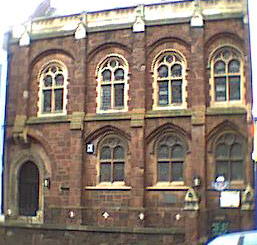 |
There is no contemporary evidence for the existence of a gild of Weavers, Fullers and Shearmen or of any association for cloth-workers in C15th Exeter except in the Mayors court roll of 1459 (Youings 1968). However an organisation called the Fraternity of the Assumption of the Blessed Virgin was in existence prior to 1459 and it was this fraternity that built the Chapel of the Assumption of the Blessed Virgin Mary, which later became known as Tuckers Hall. Craft gilds appeared in Exeter in the latter part of C14th, the Cordwainers and Curriers were the first recognised by the City authorities in 1387. However, in 1179, Henry II was pleased to accept a fine of £40.00 from the citizens of Exeter for having formed gilds. Cheeky bastard! There is a reference to a Merchants gild in 1189 and references to a gild of Bakers in 1428, Tailors in 1466, Barbers' in 1487 and Cappers and Habberdashers in 1492. None of these survive today. |
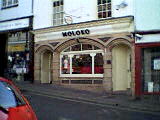
|
Devonport
Next stop is Vivo
on your left, formerly The Devonport Inn, Crazy Horse
Moloko and the Splash Bar. Crazy Horse was closed in August 2001 after under age drinkers had made it their
'local'. The resultant trouble did not help it's cause. Moloko opened in March 2002 and The Splash Bar in
July 2003. The Splash Bar closed in early 2005 with the Velvet Lounge opening in October 2005.
This bar is a gay bar but that shouldn't worry you. You don't bow easily to peer pressure. You're going for a pint!
|
|
| Bartholomew
Head over the road, up Bartholomew Street. Barts
Tavern used to stand up here on the right. The
building is known as Barts Mews and is no longer a Pub. The pub itself was converted from
a warehouse in the mid C20th and has in the past been known as The Merry Monk and The Exeter Inn.
Further on is the Picture Palace cinema.
Before conversion to a cinema, this place was
once home to Percy Sercombe & Sons (later taken over by Fyffes), who
were Fruit and Veg Merchants.
Twelve 15 ton delivery lorries were squeezed into here at 5pm every day
together with offices for the running of the business.
Fyffes relocated to Marsh Barton in 1974 and the warehouse became a
sanitary-ware store (bogs 'n basins) before being converted to a cinema.
The cinema seats 350 and was developed in 1996. It is very comfortable,
I was able to watch Titanic here without developing a numb bum. The project
cost 790,000, 73 per cent of which came from a National Lottery Grant.
Opening was put off several times because of the discovery of archaeological
remains on the site. Some of these are displayed in the bar upstairs.
|
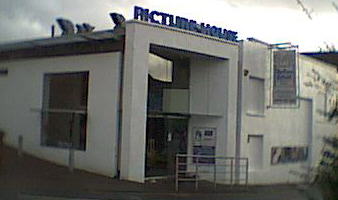
Just past the cinema on the bend of the road is Bartholomew Terrace. This is a group of C18th and C19th buildings in various architectural styles following the line of the City Wall. At the south west angle of the wall was the medeival Snayle Tower (1437). If you want an excellent view of the river and flood prevention schemes, St Thomas and Alphington, this is your best vantage point. |
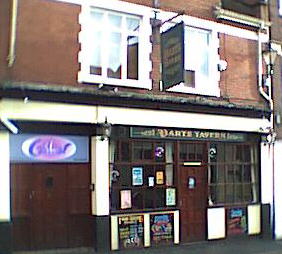 |
New Bridge Street
Head back to Fore Street and turn right. Here Fore Street becomes New Bridge Street, and was opened as a link to a new Exe Bridge built in 1778. At this time All Hallows Church stood at the bottom of Fore Street. It was demolished to build New Bridge Street and was re-built in Bartholomews Yard. It was used as a factory during WW2 and eventually pulled down. The name Bartholomews Yard was given to a new cemetry opened on St Bartholomews Day 1637, it was closed in 1832 after the burial of Exeter's last cholera victim. Part of the 1778 Exe bridge can still be seen if you drop into the landscaped area housing a medieval bridge and St Edmunds Church, which you'll see to your left. After the bridge was built, Frog Street linked to Tudor Street under the bridge forming a major throroughfare linking Exe Island with Westgate. The Round-tree Inn stood below the bridge. Also in this viscinity was the City Brewery, demolished in 1970. The brewery was actually integrated into the structure of the medeival bridge, some of its cellars being the arches of the bridge. Further down the street just before the bridge, Commercial Road crossed the new street to link with Bonhay Road. On the right hand side of the road at the end of the railing are some steps that will take you down to Western Way and Tudor Street over over the road. This is the location for your final pub stop, the Queen Victoria with it's mock Tudor facade. |
|
|
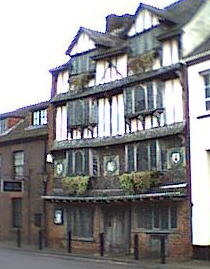 |
| Tudor
If you're after the real thing however, look further along Tudor Street
and find the Tudor House, which officially dates from 1660, however it could well be much older. It was carfully restored
by it's owner in the late 1960's. The crests that can be seen on the front of the house are those of very well known old
Exeter families. Those of the Tuberville, Leach and Duntze families.
As mentioned earlier this Street was once an important link
betwwen the Westgate area and Exe Island. Where the modern Office block now stands was an industrial area
back in 1876 with Iron Foundries etc.
The Anchor Inn stood in the Square. Toward the river was the
original Cattle market, the Shakespeare Inn with the Cattle Market Inn close by. The limestone building occupied
by the plumbers merchants is Miss Hall, also shown on a map of 1876.
|
Early Energy
One of Exeter's first gas works stood at the end of Tudor Street, the company
later moving to Haven Banks. This was the Exeter Gas Light and Coke Company.
Exeter pioneered the use of gas for light in the West Country with the company
being founded here in 1815. A rival company was established on Haven Banks next door to the Welcome Inn in 1836.
May 1st 1939 saw the two companies merge and in 1870 this Exe Island site was shutdown. Nowadays we use natural
North Sea Gas.
After 1870, their site became the site of the Public Abattoirs.
You are not far from the Quay or St
Thomas now. The choice is yours.
|